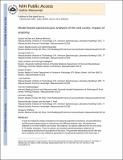Model-based spectroscopic analysis of the oral cavity: impact of anatomy
Author(s)
McGee, Sasha; Mirkovic, Jelena; Mardirossian, Vartan; Elackattu, Alphi; Yu, Chung-Chieh; Kabani, Sadru; Gallagher, George; Pistey, Robert; Galindo, Luis H.; Badizadegan, Kamran; Wang, Zimmern; Dasari, Ramachandra Rao; Feld, Michael S.; Grillone, Gregory; ... Show more Show less
Downloadfull manuscript (919.9Kb)
PUBLISHER_POLICY
Publisher Policy
Article is made available in accordance with the publisher's policy and may be subject to US copyright law. Please refer to the publisher's site for terms of use.
Terms of use
Metadata
Show full item recordAbstract
In order to evaluate the impact of anatomy on the spectral properties of oral tissue, we used reflectance and fluorescence spectroscopy to characterize nine different anatomic sites. All spectra were collected in vivo from healthy oral mucosa. We analyzed 710 spectra collected from the oral cavity of 79 healthy volunteers. From the spectra, we extracted spectral parameters related to the morphological and biochemical properties of the tissue. The parameter distributions for the nine sites were compared, and we also related the parameters to the physical properties of the tissue site. k-Means cluster analysis was performed to identify sites or groups of sites that showed similar or distinct spectral properties. For the majority of the spectral parameters, certain sites or groups of sites exhibited distinct parameter distributions. Sites that are normally keratinized, most notably the hard palate and gingiva, were distinct from nonkeratinized sites for a number of parameters and frequently clustered together. The considerable degree of spectral contrast (differences in the spectral properties) between anatomic sites was also demonstrated by successfully discriminating between several pairs of sites using only two spectral parameters. We tested whether the 95% confidence interval for the distribution for each parameter, extracted from a subset of the tissue data could correctly characterize a second set of validation data. Excellent classification accuracy was demonstrated. Our results reveal that intrinsic differences in the anatomy of the oral cavity produce significant spectral contrasts between various sites, as reflected in the extracted spectral parameters. This work provides an important foundation for guiding the development of spectroscopic-based diagnostic algorithms for oral cancer.
Date issued
2008-12Department
Massachusetts Institute of Technology. Department of Physics; Massachusetts Institute of Technology. Spectroscopy LaboratoryJournal
Journal of Biomedical Optics
Publisher
Society of Photo-optical Instrumentation Engineers
Citation
McGee, Sasha et al. “Model-based spectroscopic analysis of the oral cavity: impact of anatomy.” Journal of Biomedical Optics 13.6 (2008): 064034-15.
Version: Author's final manuscript
ISSN
1083-3668
Keywords
spectroscopy, reflectance, fluorescence